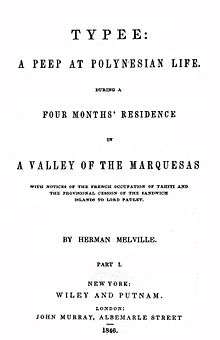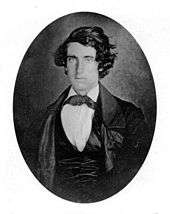Typee
 First edition title page | |
| Author | Herman Melville |
|---|---|
| Country | United States, England |
| Language | English |
| Genre | Travel literature |
| Published |
|
| Media type | |
| Followed by | Omoo |
Typee: A Peep at Polynesian Life is the first book by American writer Herman Melville, published first in London, then New York, in 1846. Considered a classic in travel and adventure literature, the narrative is partly based on the author's actual experiences on the island Nuku Hiva in the South Pacific Marquesas Islands in 1842, liberally supplemented with imaginative reconstruction and adaptation of material from other books. The title is from the province Tai Pi Vai. Typee was Melville's most popular work during his lifetime; it made him notorious as the "man who lived among the cannibals".[1]
Background
Typee is "in fact, neither literal autobiography nor pure fiction". Melville "drew his material from his experiences, from his imagination, and from a variety of travel books when the memory of his experiences were inadequate."[1] He departed from what actually happened in several ways, sometimes by extending factual incidents, sometimes by fabricating them, and sometimes by what one scholar calls "outright lies".[2]
The actual one-month stay on which Typee is based is presented as four months in the narrative; there is no lake on the actual island on which Melville might have canoed with the lovely Fayaway, and the ridge which Melville describes climbing after escaping the ship he may actually have seen in an engraving. He drew extensively on contemporary accounts by Pacific explorers to add to what might otherwise have been a straightforward story of escape, capture, and re-escape. Most American reviewers accepted the story as authentic, though it provoked disbelief among some British readers.

Two years after the novel's publication, many of the events described therein were corroborated by Melville's fellow castaway, Richard Tobias "Toby" Greene.[1]
Critical response

Critical opinion on Typee is divided. Scholars have traditionally focused attention on Melville's treatment of race and the narrator's portrayal of his hosts as noble savages, but there is considerable disagreement as to what extent the values, attitudes, and beliefs expressed are Melville's own, and whether Typee reinforces or challenges racist assessments of Pacific culture.
Typee's narrative did express sympathy for the so-called savages, while criticizing the missionaries' attempts to civilize them:
It may be asserted without fear of contradictions that in all the cases of outrages committed by Polynesians, Europeans have at some time or other been the aggressors, and that the cruel and bloodthirsty disposition of some of the islanders is mainly to be ascribed to the influence of such examples.
[The] voluptuous Indian, with every desire supplied, whom Providence has bountifully provided with all the sources of pure and natural enjoyment, and from whom are removed so many of the ills and pains of life—what has he to desire at the hands of Civilization? Will he be the happier? Let the once smiling and populous Hawaiian islands, with their now diseased, starving, and dying natives, answer the question. The missionaries may seek to disguise the matter as they will, but the facts are incontrovertible. CH 4
In Typee, the character Tommo is terrified of being permanently absorbed into native society, and critics have given much attention to his fear of cannibalism. The novel states that Typee natives ate an inhabitant of one of the neighboring valleys, but the natives who captured Melville reassured him that he would not be eaten.
Typee may have provided the writers Louis Becke, Jack London, and Robert Louis Stevenson with the themes and images of the Pacific experience: cannibalism, colonialism, cultural absorption, exoticism, natural plenty and beauty, and a perceived simplicity of native lifestyle, desires and motives.
The Knickerbocker called Typee "a piece of Münchhausenism".[3] New York publisher Evert Augustus Duyckinck wrote to Nathaniel Hawthorne that "it is a lively and pleasant book, not over philosophical perhaps."[4]
Publication history
Typee was published first in London by John Murray on February 26, 1846, and then in New York by Wiley and Putnam on March 17, 1846.[5][6]
The same version was published in London and New York in the first edition; however, Melville removed critical references to missionaries and Christianity from the second U.S. edition at the request of his American publisher. Later additions included a "Sequel: The Story of Toby" written by Melville, explaining what happened to Toby.
Before Typee's publication, the publisher asked Melville to remove one sentence. In a scene where the Dolly is boarded by young women from Nukuheva, Melville originally wrote:
Our ship was now given up to every species of riot and debauchery. Not the feeblest barrier was interposed between the unholy passions of the crew and their unlimited gratification.
The second sentence was removed from the final version.[7]
The inaugural book of the Library of America series, titled Typee, Omoo, Mardi (May 6, 1982), was a volume containing Typee: A Peep at Polynesian Life, its sequel Omoo: A Narrative of Adventures in the South Seas (1847), and Mardi, and a Voyage Thither (1849).[8]
References
Bibliography
- Herbert, T. Walter (1980). Marquesan Encounters: Melville and the Meaning of Civilization. Cambridge, MA: Harvard University Press. ISBN 0674550668.
- Howard, Leon (1968), "Historical Note", in Melville, Herman, Typee: A Peep at Polynesian Life the Writings of Herman Melville Vol. 1, Evanston, IL: Northwestern University Press, pp. 277–302, ISBN 9780810101593
- Melville, Herman (1968). Typee: A Peep at Polynesian Life. 1. Evanston, IL: Northwestern University Press. ISBN 9780810101593.
- Miller, Perry. (1956). The Raven and the Whale: The War of Words and Wits in the Era of Poe and Melville. New York: Harvest Book.
- Nelson, Randy F. (1981). The Almanac of American Letters. Los Altos, California: William Kaufmann, Inc. ISBN 0-86576-008-X
- Widmer, Edward L. (1999). Young America: Flowering of Democracy in New York City. New York: Oxford University Press. ISBN 0-19-514062-1
External links
| Wikisource has original text related to this article: |
- Typee at Project Gutenberg
- Typee, 1846 first edition, scanned book via Internet Archive, other later editions available.
-
 Typee public domain audiobook at LibriVox
Typee public domain audiobook at LibriVox - Typee, Fluid Text Edition at the University of Virginia Press